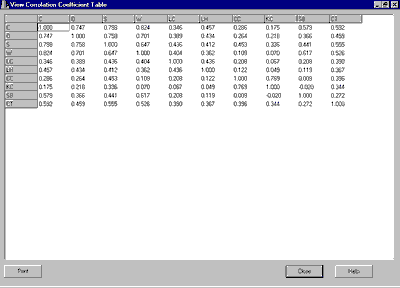
The correlation coefficients displayed here are statistical measures of how each market relates to the others. A correlation coefficient has two parts: the sign and the magnitude. The magnitude, also known as the absolute value, ranges from zero to one and indicates the strength of the relationship. The sign, positive or negative, indicates the direction. A value of 1.0 is perfect positive correlation – the first market and the second market move up and down together in unison. Of course, each market is perfectly correlated with itself, which is why you see 1.0 on the main diagonal from top left to bottom right.
Two markets that move perfectly opposite to each other – one goes up and the other goes down – have a correlation coefficient of –1.0, perfect negative correlation. This is very rare. A correlation coefficient of zero indicates no relationship at all – also very rare. A very crude rule of thumb for the strength of relationship based on the absolute value (drop the minus sign for negative coefficients) is ([Williams1968], page 134). See the following table.
0.00 – 0.20: slight; almost negligible relationship
0.20 – 0.40: low correlation; definite but small relationship
0.40 – 0.70: moderate correlation; substantial relationship
0.70 – 0.90: high correlation; marked relationship
0.90 – 1.00: very high correlation; very dependable relationship
Armed with these definitions, what does the correlation between two markets mean to a trader? In general, unless you are trading very specific spreads or arbitrages, you want to be as diversified as possible and avoid taking positions at the same time in highly correlated markets. For example, if you're a trend follower, you will find that highly correlated markets enter trends together, giving entry signals typically the same day or within a day or two. Taking all of these highly correlated signals is equivalent to pyramiding – amplifying your risk.
If you are trading futures to diversify a total portfolio, which might include real estate, stocks and bonds, you will achieve better diversification if you ignore stock index futures like SP, bond futures like US and other contracts that are highly correlated. This is why we've chosen agricultural futures for our example – historically they show low-magnitude correlations with stocks, bond and real estate. The underlying development intent of MMA is to help the user-analyst to explore opportunities where correlated markets depart from each other and develop opportunities where by buying one and selling the other, the correlated pair will return to a satisfactory level of equilibrium.
One other note of caution: in some books you will see recommendations to take simultaneous positions in markets with high negative correlation as a way to reduce risk. Technically this is correct if you are taking a long position in both markets, as would normally be the case for common stocks. But in the futures markets, you can take either a long position or a short position with equal ease.
Given a pair of futures contracts with high negative correlation, a trend-following system would very likely recommend a long position in one market and a short position in the other market. As noted above, this is equivalent to an amplification of risk. For futures trend following, diversification is achieved by using markets with low-magnitude correlation coefficients – near zero with either sign.
Let's look at this table with the correlation coefficients sorted by magnitude:
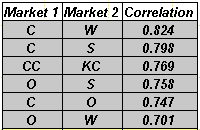 High
High
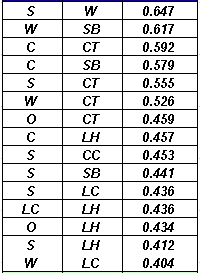 Moderate
Moderate
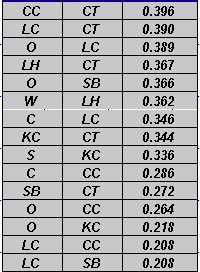 Low
Low
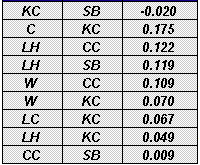 Slight
Slight
At the top of the list, we find that corn is highly correlated with wheat and soybeans. Thus, if you were following the three markets with a trend-following system and got a signal to go short or long in one of them, chances are the other two would give signals in the same direction the same day or soon after. To maintain diversification, you would not want to take all of the signals. You might consider using the first signal from the group of three as a setup, entering a trade in one of them when the other two followed, confirming the trend. Also at the top of the table, coffee and cocoa are highly correlated with each other. However, their correlations with corn are low, so if you were holding a position in corn when you got a signal in KC or CC or both, you would be diversifying by taking one signal from the pair.
The other fact to be noted about high-correlation pairs is that they define where opportunities for inter-crop spreads are found. Such spreads, long in one contract and short in another highly correlated contract, are considered low risk and qualify in some cases for reduced margins. We will have more to say about inter-crop spreads later.
Looking at the bottom of the list, we see that sugar (SB), cocoa (CC) and coffee (KC) have only slight or low correlations with many of the other commodities. This makes them ideal for diversification and means they are worth following.
When you are finished looking at the correlation coefficients, press the "Close" button to return to the "Factor Analysis" screen. For more information on correlation and diversification in the futures markets, see [Balsara 1992], chapter 4.